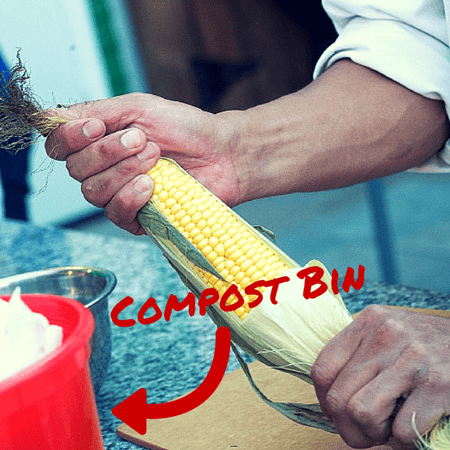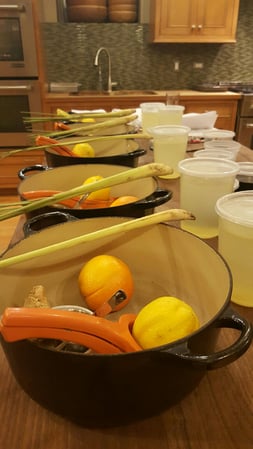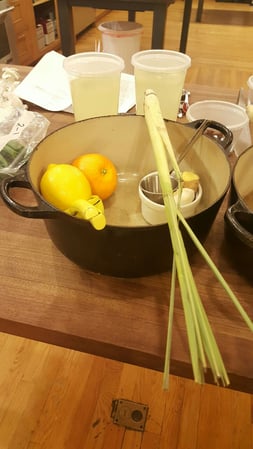If there is one thing anyone in the culinary world knows, it's that cleaning and organizing is 50% of cooking. But you don't have to be a professional chef to adopt some of the tried and true methods used to keep our kitchens in top condition, giving you more time to do what you enjoy (cooking) and less time doing dishes.
1. Compost Bucket/ Garbage Bowl
At The Chopping Block, we provide compost buckets during class and in our prep kitchen. All food scraps and even paper (as the saying goes, anything that was once alive) can be dumped into the bucket as we cook, keeping our prep surfaces clear of peels and food debris.
 While we have a composting service that collects our sizable haul of compost each day, at home, you might not have the same arrangement. If you'd like to get into composting (and the planet will love you for it) there are a few places here in Chicago that will pick up compost from residences, like Collective Resource, for a small fee on a weekly or biweekly basis; or you can even learn the art of vermicomposting. But even if that's not feasible, it's much less of a hassle to continuously keep a "garbage" bowl or bucket on your work surface to collect scraps, seeds and skins, making countertops and floors a snap to clean at the end of the night.
While we have a composting service that collects our sizable haul of compost each day, at home, you might not have the same arrangement. If you'd like to get into composting (and the planet will love you for it) there are a few places here in Chicago that will pick up compost from residences, like Collective Resource, for a small fee on a weekly or biweekly basis; or you can even learn the art of vermicomposting. But even if that's not feasible, it's much less of a hassle to continuously keep a "garbage" bowl or bucket on your work surface to collect scraps, seeds and skins, making countertops and floors a snap to clean at the end of the night.
2. Soap and Water Everything
Before I started at The Chopping Block, I was always spraying down my tables and countertops with things labeled "counter spray", which I admittedly chose based on the prettiest packaging. And my stovetop? I thought you needed to ajax the heck out of it, making me less likely to want to engage in the process, much to the chagrin of my roommates. After seeing plain old soap and water used on everything from metal prep tables to dining room furniture, to hoods and range tops, with sparkling results, I've adopted a similar approach at home. Plus it feels like everything is extra clean, not just "wiped away." The trick is hot water and a little bucket (have you caught on to how much we love little buckets yet?) to hold your sponge and slightly soapy water (a couple drops'll do ya). Carry around your portable sponge station and wipe down everything (after removing crumbs, of course), then wipe it dry with a fresh kitchen towel. Additional bonus is that soap is budget friendly and saves space in your cleaning arsenal so you can fill it with more ramekins or whatever your kitchen weakness may be.
3. Mise En Place For Fewer Dishes and Faster Cooking
Mise En Place, or "everything in its place," is an integral part of cooking at The Chopping Block and any commercial kitchen, and there is a definite art to it, complete with individual variations and preferences. The basic idea is to assemble measured ingredients, vessels and utensils in the most efficient way so trips back and forth are minimized and going "now wheres the whatsit oil" while the garlic burns to a crisp is practically eliminated. One of the best things about Mise En Place for the home cook is that it prizes using the fewest dishes possible. For example, measuring all dry ingredients into one bowl with one measuring utensil. That's something everyone can agree on!
 The more often you mise, the easier it gets. Read through your recipe before you make it, grouping ingredients that are added at the same time, highlighting special equipment or vessels that will be needed, and thinking through how to use the least amount of platters, plates and measuring equipment. A little extra recipe deconstruction beforehand could cut cooking and cleaning time literally in half when you're hungry and just wanna put your feet up and enjoy a glass of wine.
The more often you mise, the easier it gets. Read through your recipe before you make it, grouping ingredients that are added at the same time, highlighting special equipment or vessels that will be needed, and thinking through how to use the least amount of platters, plates and measuring equipment. A little extra recipe deconstruction beforehand could cut cooking and cleaning time literally in half when you're hungry and just wanna put your feet up and enjoy a glass of wine.
 Want to learn how to mise en place like the pros? Experience a cooking class at The Chopping Block. Our March calendar is now available!
Want to learn how to mise en place like the pros? Experience a cooking class at The Chopping Block. Our March calendar is now available!












